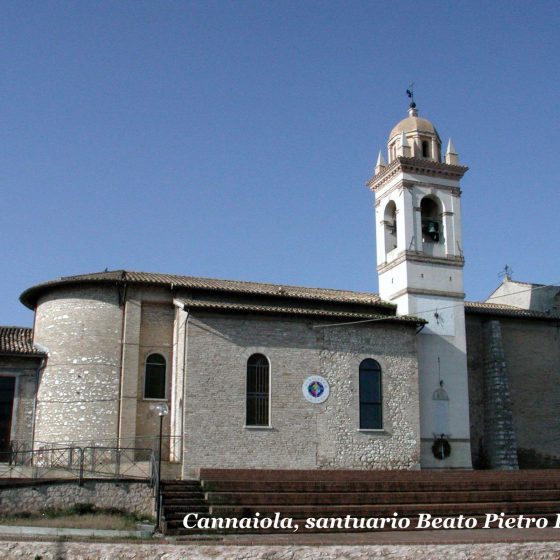Al centro del paese, su un terrapieno opportunamente predisposto per evitare eventuali allagamenti, si erge la chiesa Parrocchiale dedicata a San Michele Arcangelo.
Eletta santuario, accoglie oggi le spoglie mortali del beato Pietro Bonilli, elevato agli onori degli altari da papa Giovanni Paolo II il 24 aprile 1988.
L’inizio della costruzione della chiesa è datato intorno al 1602, ma nel corso degli anni è stata più volte ampliata e rimaneggiata.
Oggi si presenta internamente in stile barocco mentre la copertura è stata modificata ulteriormente da pochi decenni e le volte a crociera sono state sostituite da capriate in legno e pianelle, di stile francescano.
Nel 1606 fu completata anche l’edificazione del campanile, di forma quadrata, che ha mantenuto inalterata nel tempo la sua struttura originaria e costituisce, quindi, un interessante esempio dell’architettura di quel periodo.
Sul lato destro, per chi entra nella chiesa, è posto il simulacro di san Marice, martire romano e co-protettore di Cannaiola dal lontano 1647.
Ai piedi della statua si conservano i suoi resti mortali, concessi ai fedeli da papa Innocenzo X nel 1648, successivamente alla riapertura delle catacombe romane.
Insieme a s. Marice, lo stesso Papa concesse anche le reliquie dei martiri Abbondio, Adriano, Giocondo, Maurizio, Quirino e Teodoro.
Anche queste sono conservate nel santuario, all’interno di alcune teche.
Sulla parete sinistra della chiesa troviamo un crocefisso ligneo di stile barocco.
In seguito agli eventi sismici che nel 1997 hanno sconvolto questa parte dell’Umbria, nel 1998 le spoglie mortali del beato Pietro Bonilli, già ricomposte in un’urna di vetro, vennero trasferite nella chiesa parrocchiale di Cannaiola.
Precedentemente erano conservate nella chiesa di San Filippo a Spoleto, danneggiata, appunto, da quegli eventi.
Oggi sono visibili all’interno della cappella laterale sinistra, sormontate da una vetrata artistica, realizzata nel 1999 dallo studio Moretti-Caselli di Perugia, la cui immagine sintetizza in modo mirabile l’opera di carità più significativa avviata in vita dal Sacerdote.
La chiesa di Cannaiola conserva importanti ricordi dei 34 anni che il beato Bonilli trascorse come parroco nel paese.
Tra questi citiamo un confessionale in noce da lui utilizzato, un “Gesù Bambino” barocco in cera e un maestoso gruppo statuario della santa Famiglia di Nazareth.
Questo fu fatto realizzare dal Bonilli a Lecce, nel 1889, nella bottega di Pasquale Conte, secondo un’iconografia inedita, suggerita dallo stesso e che rappresenta Gesù in età adolescenziale.
Il gruppo statuario si può oggi ammirare nel presbiterio, all’interno di una mostra d’altare lignea seicentesca, ulteriore testimonianza delle ricchezze custodite nella nostra pianura, apparentemente così povera di tesori d’arte.
Opere che certamente meritano la visita dell’ospite più attento, che potrà trarre da questo viaggio di conoscenza non poche soddisfazioni.
TREVI, CANNAIOLA, SANCTUARY OF BLESSED BONILLI
In the center of Cannaiola, on an embankment suitably built to avoid any possibility of flooding, stands the parish church dedicated to San Michele Arcangelo.
Erected as a sanctuary, today it houses the mortal remains of Blessed Pietro Bonilli raised to the honors of the altars by Pope John Paul II on April 24, 1988.
The church’s construction began around 1602, but over the years it has been enlarged and remodeled several times.
Inside it has a Baroque style while the roof was further modified a few decades ago and the cross vaults have been replaced by wooden trusses and Franciscan style tiles.
In 1606, the construction of the square bell tower was completed, which has maintained its original structure unchanged over time and therefore constitutes an interesting example of the architecture of that period.
On the right side, for those entering the church, there is the simulacrum of San Marice, a Roman martyr and co-protector of Cannaiola since 1647.
At the foot of the statue are his mortal remains, granted to the faithful by Pope Innocent X in 1648, following the reopening of the Roman catacombs.
Together with Saint Marice, the same Pope also granted the relics of the martyrs Abbondio, Adriano, Giocondo, Maurizio, Quirino and Teodoro. These are also kept in the sanctuary inside some display cases.
On the left wall of the church we find a wooden crucifix in the Baroque style.
Following the seismic events of 1997, which shook this part of Umbria, in 1998 the mortal remains of Blessed Pietro Bonilli, already reassembled in a glass urn, were transferred to the parish church of Cannaiola. Previously they were kept in the church of San Filippo in Spoleto, damaged by those events.
Today the mortal remains of the Blessed are visible inside the left side chapel, surmounted by an artistic stained glass window created in 1999 by the Moretti-Caselli studio in Perugia: an image that admirably summarizes the most significant work of charity started in life from Bonilli.
The church of Cannaiola preserves important memories of the 34 years that Pietro Bonilli spent as parish priest in the town.
Among these there a walnut confessional he used, a baroque wax ‘Baby Jesus’ and a majestic statuary group of the Holy Family of Nazareth. This was commissioned by Bonilli in Lecce, in 1889, in the workshop of Pasquale Conte, according to an unpublished iconography suggested by himself and which represents Jesus in adolescence.
The statuary group can now be admired in the presbytery inside a seventeenth-century wooden altar exhibit, further evidence that our region preserve far more treasures than is commonly known.
Works that certainly deserve the visit of the most attentive guest, who will be able to draw from this journey of knowledge not a few satisfactions.
The translation of this post is edited by Patrizia ANTONELLI

